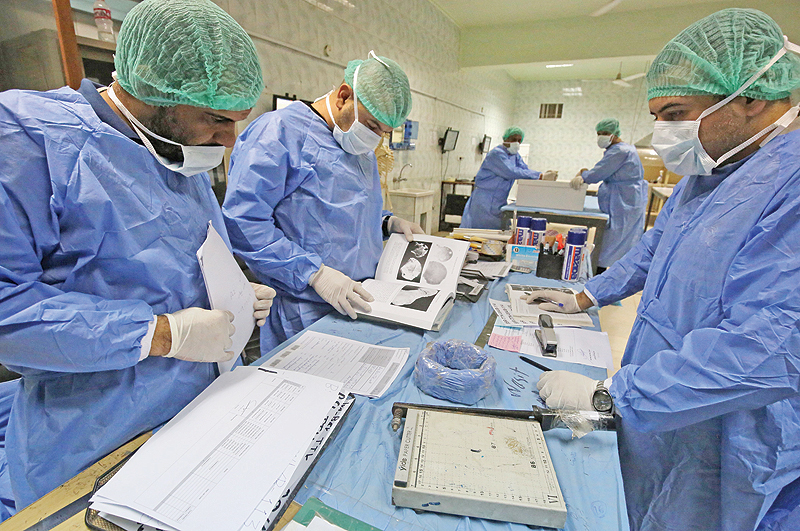Entire families massacred; women, girls pushed into 'sex slavery'
BAGHDAD: Six drops of blood and a vial of ground-up bone: a sample of evidence that an Iraqi forensics lab has gathered of the Islamic State group's multiple brutal crimes against the Yazidis. "It's like a puzzle," says forensic specialist Mohammad Ihsan from behind a medical mask, as he lays out yellowed bones under fluorescent lights at the shabby Medico-Legal Directorate in eastern Baghdad.
The bones, recently exhumed from mass graves in the Yazidi stronghold of Sinjar in northwest Iraq, will be compared with blood samples from surviving members of the community to help determine the fates of those still missing after IS's 2014 rampage through their villages. Entire families were massacred, boys forcibly recruited to fight and women and girls pushed into "sex slavery" in what the United Nations has said could amount to "genocide".
Five years on, a joint criminal investigation is seeking to bring legal and emotional closure to the ethno-religious minority. But the high-profile probe has been complicated by weathered evidence and the difficulty of building a genetic database for a community as insular as the Yazidis, where the search for DNA may take scientists as far as Australia. Since March, the bones, hair and personal belongings from 12 grave sites in Sinjar have been brought to Ihsan's lab, which builds an initial biological profile of the victim including height and gender. "Our trauma specialists determine the cause of death, the fractures and injuries," he adds.

'Families wiped out'
Specialists then try to identify victims through their DNA, best preserved in the femur and teeth. These items are ground into a fine powder and run through machines to match them with blood samples drawn from Yazidi survivors and dripped onto a piece of paper. "The newer the body you're testing, the better you can extract the DNA," says genetics analyst Mais Nabil.
But the graves in Sinjar were packed with bodies and exposed to floods, fires and fighting over five years, making the samples less than ideal. "Sometimes, we're getting samples that are very deteriorated, and we can only try a few times to extract the DNA before it is no longer usable," Nabil tells AFP. Then comes the identification process. The Yazidi community numbered 550,000 in northwestern Iraq before 2014, but IS's rampage forced 100,000 to flee abroad and several times that number into displacement camps.
Mass violence against a minority often means there are more victims than survivors in each family, and the rate of intermarriage among Yazidis is so high that DNA samples do not necessarily provide a definitive profile. "There are families that were completely wiped out. Who would register the missing person's name in that case?" says Amer Hammoud, associate director at the Medico-Legal Directorate.
His facility has logged the names of 1,280 missing individuals, is storing 1,050 blood sample cards, and is awaiting another 2,600 samples from Kurdish authorities. But the real trove of evidence is abroad. "There are 2,200 Yazidi families in Germany that I aspire to reach so I can get DNA samples to match. There are 800 families in Australia, 800 in Canada and nearly 150 in France. This list would be bigger than the samples we have here in Iraq," says Hammoud.
'Never be at ease'
Just 10 years old, his facility has been examining victims of decades of violence in Iraq. The cardboard boxes containing evidence from Sinjar are surrounded by identical cartons labelled "Anfal," "Karrada," and "Basra," -- respectively storing evidence from a massacre of Kurds in the 1980s, a 2016 explosion in Baghdad and a province hit by the Iran-Iraq war of the 1980s. "We've had years of experience identifying victims. But to minimise the margin of error here, we need time," he says.
The exhumation and identification efforts are supported by the UN special probe into IS crimes (UNITAD), which is gathering evidence and witness testimony for eventual trials in "national courts", perhaps including Iraq. Those cases could take years to put together, but Bashar Hamad is desperate for an answer much sooner. Hamad, 51, last saw his brother Nawaf in 2014 as they clambered up Mount Sinjar to flee approaching IS fighters. Nawaf set off to a nearby village to scavenge for food, but jihadists captured him and five other relatives and they were never seen again.
"There's no more Daesh (IS), and in the Al-Hol camp (housing people who once lived under IS), there are only women and children. No men," he says. Hamad and his family, who remain displaced in northwest Iraq, provided blood samples to authorities last year but have little hope of finding Nawaf alive. "We will never be at ease. As long as these events are in our memories and the whole world shuts its doors to us, we can't be," Hamad said. "But it would still be better to know."- AFP




